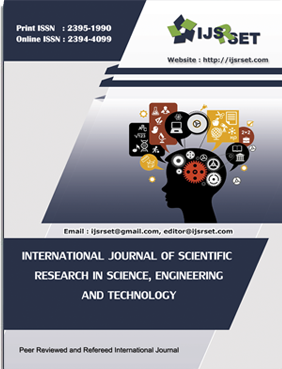Forensic Entomology : An Indian Prospective
Keywords:
Forensic entomology, Insects, Medico-legal investigation, PMIAbstract
Insects are the dominant group of animals on earth today. They occur practically everywhere and far outnumber all other terrestrial animals taken together. Several hundred thousand different kinds of insects have been described, three times as many as there are in the rest of animal kingdom and some authorities believe that the total number of different species of insects may approach 30 million. Forensic entomology is the study of insects and fauna found in and around the carcasses, and their use in the estimation of post mortem interval (PMI). The aim of the present review is to show the current status of the forensic entomology in India.
References
- Turchetto, M. and Vanin, S. 2004. Forensic entomology and climatic change. Forensic Sci. Int., 146 (Suppl.): 207-209.
- McKnight, B.E. 1981. The Washing Away of Wrongs : Forensic Medicine in Thirteenth Century China, trans. S. Tzu., University of Michigan, Ann Arbor, pp. 196.
- Hall, R.D. 1990. Medicocriminal entomology. In: Entomology and death: a procedural guide, Catts, E.P. and Haskell, N.H. (Eds.), Clemson, SC, Joyce’s Print Shop, pp. 1-8.
- Harvey, M. 2006. A molecular study of the forensically important Calliphoridae(Diptera): implications and applications for the future of forensic entomology. Ph.D. thesis. Center for Forensic Science, The University of Western Australia.
- Hall, R.D. 2001. Introduction: Perceptions and Status of Forensic Entomology, In: Forensic entomology: the utility of arthropods in legal investigations, Bryd, J.H. and Castener, J.H. (Eds.), CRC Press LLC, Boca Raton, Florida, pp. 1-16.
- Hall, M. and Amendt, J. 2007. Forensic entomology–scientific foundations and applications. Forensic Sci. Int., 169S: S27‐S28.
- Haskell, N.H., Hall, R.D., Cervenka, V.J. and Clark, M.A. (1997) On the body: insect’s life stage presence, their postmortem artifacts. In: Haglund WD, Sorg MH (Eds.) Forensic taphonomy: the postmortem fate of human remains. CRC, Boca Raton, Fla., pp. 415- 448.
- Megnin P. (1894) La Faune des Cadavres. Encyclopédie Scientifiques des Aide Memoire. Masson, Gauthier-Villars et Fils, Paris, pp. 214.
- Campobasso, C.P. and Introna, F. (2001) The forensic entomologist in the context of the forensic pathologist’s role. Forensic Sci. Int., 120: 132‐139.
- Kulshrestha, P. and Chandra, H. 1987. “Time since death. An entomological study on corpses”, American Journal of Forensic Medicine and Pathology, 8(3): 233-238.
- Kulshreshth, P. and Satpathy, D.K. 2001. “Use of beetles in forensic entomology”, Forensic Science International, 120:15- 17.
- Kulshreshtha,P. and Satpathy,D.K. 2005. “Forensic entomology analysis professional help in Karnataka case”, Journal of Indian Academy of Forensic Medicine, 27(2), 971-973.
- Singh, D. and Greenberg, B. 1994. “Survival after submergence in the pupae of five species of blowflies (Diptera: Calliphoridae)”, Journal of Medical Entomology, 31(5), 757-759.
- Greenberg, B. and Singh, D. 1995. “Species identification of calliphorid (Diptera) eggs”,Journal of Medical Entomology, 32(1):21-26,
- Subramanian, H. and Mohan, K.R. 1980.“Biology of blow flies Chrysomya megacephala, Chrysomya rufifacies and Lucilia cuprina”, Kerala Journal of Veterinary Science, 11: 252-261.
- Rao, M.B., Goyal, M.K., Kushwaha, K.P.S. and Gaur, J.R. 1984.“Experimental study of the developmental stages of maggots for estimation of time since death”, Journal of Forensic Science, 24(4):398.
- Kashyap, V.K. and Pillay, V.V.1989.“Insects and crime investigations,What is forensic entomology?”, Journal of Indian Council of Philosophical Research:12-17.
- Kashyap, V.K. and Pillay, V.V. 1989. “Efficacy of entomological methods in estimation of post mortem interval: a comparative analysis”, Forensic Science International, 40, pp. 245-250, 1989.
- Bharti, M. and Singh, D. 2003 “Insect faunal succession on decayed rabbit carcasses in Punjab, India”, Journal of Forensic Science, 48: 1133- 1143.
- Gupta, A. and Setia, P. 2004. “Forensic entomology-past,present and future”, Aggrawal’s Internet Journal Forensic Medicine Toxicology, 5(1):50-53.
- Singh, D. and Bharti, M. 2000. “Forensically important blow flies (Diptera: Calliphoridae) of Punjab (India)”, Uttar Pradesh J ournal of Zoology, 20(3): 249-251.
- Singh, D. and Bharti, M. 2001. “Further observations on the nocturnal oviposition behavior of blow flies (Diptera: Callpiphoridae)”, Forensic Science International, 120, pp. 124-126, 2001.
- Bajpai, N. and Tewari, R.R. (2010) Mitochondrial DNA sequence-based phylogenetic relationship among flesh flies of the genus Sarcophaga (Sarcophagidae: Diptera). J. Genet., 89: 51-54.
- Sharma,M., Singh, D. and Sharma, A. 2014. Identification of three forensically important Indian species of flesh flies (Diptera: Sarcophagidae) based on cytochrome oxidase I gene. Indian Journal of Forensic Medicine and Toxicology, 8(1): 12-16.
- Sharma, M., Singh, D. and Sharma, A. 2015. Mitochondrial DNA based identification of forensically important Indian flesh flies (Diptera: Sarcophagidae). Forensic Science International, 267 (2015): 1-6.
Downloads
Published
Issue
Section
License
Copyright (c) IJSRSET

This work is licensed under a Creative Commons Attribution 4.0 International License.

